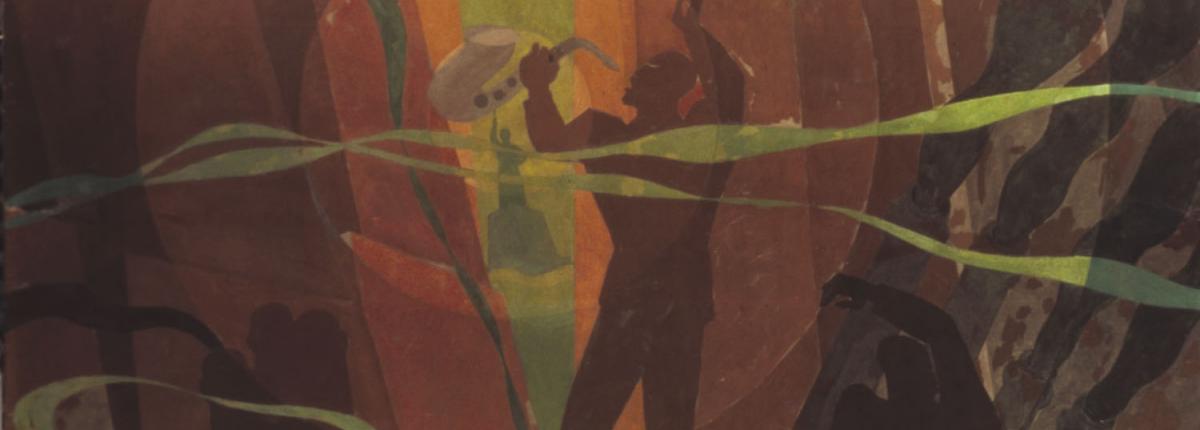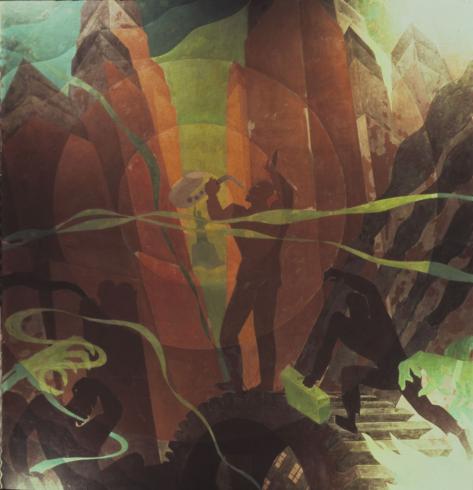Storytelling Community Mural

Part 1: Discussion
Compare the similarities and differences between the style and narratives in Douglas’s Aspects of Negro Life: Song of the Towers and Lawrence’s Migration Series: Panel no. 45:
- Have students closely examine each painting by using the Artful Thinking Routine of Looking: Ten Times Two.
- Notice the paintings’ styles:
- What kinds of colors does each artist use?
- What shapes, patterns, and designs do you notice in each painting?
- Analyze the paintings’ stories:
- What symbols do you notice? What might they signify?
- Weaving together the observations from the looking activity and discussion, what story does each painting tell?
- What about the story is positive? What about the story is negative?
Part 2: Art Tells Stories
SYNTHESIZE the newfound knowledge of Douglas and Lawrence’s artistic styles and ways of storytelling, and create your own painting or mural to EXPRESS a story of your community. This can be an individual, group, or class project. Consider the following questions when making your painting:
- What style reflects your community? Do certain patterns or designs reflect your community’s identity?
- What are both positive and negative aspects of being in your community?
- What part of your community’s history is important to who your community is today?
- What do you want to convey about your community? What parts of your community do you intentionally want to leave out of your artwork?
Additional Context
Lesson Context
In the 1920s, Harlem became a coveted address. The neighborhood in New York City was synonymous with an outpouring of production in the visual arts, music, literature, theater, and dance. This creative era came to be called the Harlem Renaissance.
Jacob Lawrence moved to Harlem when he was 13 and grew up in this vibrant community. He took art classes at the Utopia House and the Harlem Workshop while carefully observing the activity and rhythms of Harlem’s daily life.
Lawrence grew up among some of the most well-known African-American thinkers during the Harlem Renaissance. He lived in the same building as the poet Claude McKay and attended the Apollo Theater where he recalled viewing performances in which “everything was jagged, bright, and brittle…so maybe my color and my shapes have this quality and developed out of that experience.”
Key Terms
Great Migration: In the Southern US, African Americans endured blatant discrimination and segregation as part of Jim Crow laws, as well as poor economic conditions. In the hopes of improved living and working conditions, hundreds of thousands of African Americans migrated from the South to the North, in particular to Chicago, Los Angeles, Detroit, Philadelphia, and New York, between 1916-1940. The Great Migration happened in two major waves: the first one being from 1916-1940 and the second one from 1941-1970.
Harlem Renaissance: The largest concentration of African Americans who migrated during the Great Migration moved to Harlem. From the 1910s to mid-1930s, the neighborhood of Harlem in New York City became a hub of African-American culture, with an explosion of literature, music, theater, and the arts.
Reconstruction: The Reconstruction era in the United States immediately followed the American Civil War, from 1865-1877, and the end of Slavery. The American government attempted to address slavery and its lasting effects, including political, social, and economic inequities, as well as new issues that arose from the 11 Confederacy states rejoining the Union. Despite Reconstruction efforts, many states enacted laws that perpetuated inequities and restricted African Americans’ civil rights.
Works Progress Administration (WPA): The WPA was established in 1935 to help counteract some of the effects from the Great Depression of 1929. The WPA hired millions of workers to build public infrastructure, in particular buildings and roads, throughout the US.

